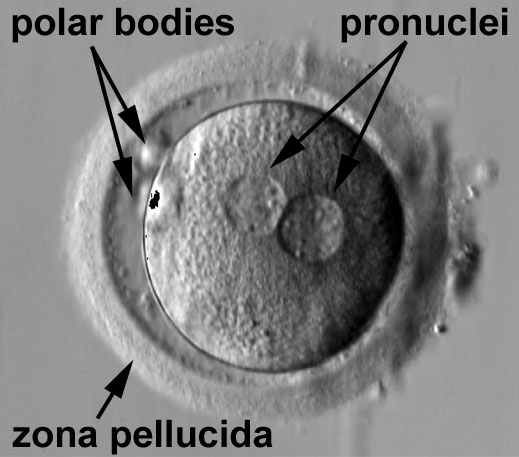K12 Week 1: Difference between revisions
| Line 50: | Line 50: | ||
Advanced note - a few genes are also located in | |||
Advanced note - a few genes are also located in every cell outside the nucleus, in the mitochondria (mitochondrial DNA) which are needed for cell respiration. These mitochondrial genes are always inherited from your mother (the egg) not your father (sperm). | |||
{{Footer}} | {{Footer}} | ||
[[Category:K12]] | [[Category:K12]] | ||
Revision as of 20:46, 22 March 2011
Week 1 after Fertilization
- The first week of human development begins with fertilization of the egg by sperm forming the zygote.
- The zygote is the first cell of the new embryo containing a new combination of genes from mother and father.
- The zygote is a large single cell still floating free inside the uterus.
- The zygote then begins to divide each day into 2 cells, then again into 4 cells, 8, 32, 64, 128 cells and so on.
- Cell division makes each cell smaller and smaller again.
This process of fertilization occurs in all animals and plants that have a male and female.
- Question: Plants cannot move, how do they fertilize their eggs?
Facts
- The process of fertilization occurs in all animals and plants that have a male and female.
- A fertilized egg does not mean it will go on to form an embryo. Many fertilized eggs do not develop into embryos.
- In humans, usually only 1 egg is released at a time each month.
- A women will release between 300 to 400 eggs during their adult life.
- In cats, dogs and other animals several eggs can be released at once. This is one reason why these animals have many babies at once.
Words Used
cell - the basic unit of life that makes up our body.
egg - the cell from the mother that contributes half the genes of the embryo.
fertilization - a process where a single male cell (father) called the sperm and female cell (mother) called the egg are joined together.
genes - information in the cell that gives it rules on how to grow and what type of cell to become. This information is stored in DNA in the cell nucleus. (more? see Advanced note)
sperm - the cell from the father that contributes half the genes of the embryo.
uterus - the space within the mother where the embryo grows. The uterus grows when the embryo does and has lots of blood to feed the embryo and strong muscles in its walls for childbirth.
zygote - the first new cell formed after fertilization.
Advanced note - a few genes are also located in every cell outside the nucleus, in the mitochondria (mitochondrial DNA) which are needed for cell respiration. These mitochondrial genes are always inherited from your mother (the egg) not your father (sperm).
Cite this page: Hill, M.A. (2024, April 16) Embryology K12 Week 1. Retrieved from https://embryology.med.unsw.edu.au/embryology/index.php/K12_Week_1
- © Dr Mark Hill 2024, UNSW Embryology ISBN: 978 0 7334 2609 4 - UNSW CRICOS Provider Code No. 00098G
